Module 4: Clauses
Module 4: Advanced Unit
CLAUSES
Contents of Advanced Unit:
1. Phrases and functions
In the remaining modules we will discuss in-depth each phrase type, including what its internal structure is like and what kinds of external structures it tends to be included within. In the rest of this module, we will preview those discussions by returning to the notion of phrases as functional units within a larger unit.
We have already seen two primary phrase functions within the larger unit of a sentence: subject and verb phrase.
Some people call the verb phrase the “predicate,” a term you may have learned before. In our approach, I will use this term for something much more specific, introduced in Module 7.
But there is also a verb form of this word “predicate,” which is useful for thinking about the function of the VP: the function of the verb phrase is to predicate something of the subject. That is, the verb phrase on whole ascribes some property, event, state of being, action, or quality to the subject. We will talk much more about predication in Module 7.
As we have seen, the subject is prototypically an NP. So what about all of the other types of phrases, then? What are their functions?
At a simple level, we have some idea already from the titles of two phrases: AdjP and AdvP. Adjective phrases “act like” adjectives, and adverb phrases “act like” adverbs. Let’s look at some examples:
delicious pasta
super delicious pasta
super delicious green pasta
These are all examples of noun phrases; see how they could all serve as the subject of a sentence:
Delicious pasta is on the menu.
Super delicious pasta is the restaurant’s specialty.
Super delicious green pasta sounds weird.
Yet each NP has a different internal structure, and they all include adjective phrases. Check out these trees:
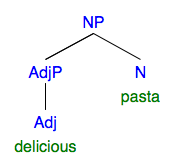
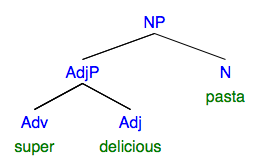
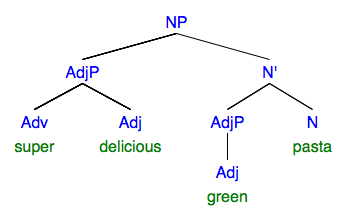
In 1, delicious modifies the noun, pasta, and together they constitute an NP.
In 2, super is an adverb that modifies the adjective delicious, and together they form an AdjP, which in turn modifies the noun, pasta, to form an NP.
In 3, green modifies the noun, pasta; the AdjP super delicious modifies the unit green pasta (we are calling this intermediate unit an N’ – remember?), and together they all form an NP.
So here we see all three different AdjPs all functioning to modify nouns—which is what we already learned that adjectives do.
Let’s also explore adverb phrases. Consider the following verb phrases:
danced beautifully
danced surprisingly beautifully
was so beautifully graceful
Recall the functions of adverbs: modifying verbs, adjectives, or other adverbs. Here we have adverb phrases doing the same thing. Check out the trees. What do you think each AdvP is functioning as?

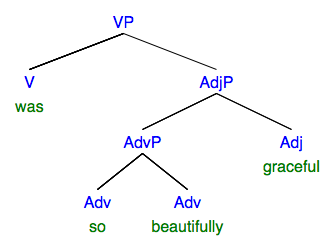
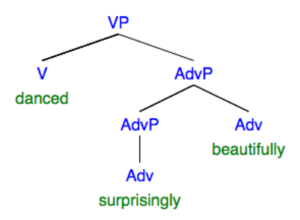
In 1, beautifully modifies the verb, danced. It tells “how.” The AdvP is part of the VP.
In 2, so modifies the adverb beautifully, and so beautifully modifies the verb danced. The AdvP is still part of the VP.
In 3, so beautifully modifies the adjective, graceful, and is part of the AdjP.
So, just like adverbs, AdvPs modify verbs, adjectives, and other adverbs.
Note that adverbs being modified by other adverbs are often modified by a sub-set of adverbs called degree adverbs. Degree adverbs cannot be the heads of an AdvP and so I never call them an AdvP phrase on their own (we could label them “deg” if we wanted to).
*She was gracefully very
*She danced incredibly really
Prepositional phrases are interesting. Think for a second: what was our definition of “preposition”?
“Prepositions introduce nouns or noun phrases into a larger phrase or sentence, to modify another unit.”
Prepositional phrases are usually functioning as modifiers. Typically, they modify nouns or noun phrases (like AdjPs do), or they modify verbs or verb phrases (like AdvPs do). Consider the following:
super delicious pasta
pasta with spinach
The PP with spinach functions to modify pasta, just like super delicious functions to modify pasta. Here, the PP has an adjectival function: modifying a noun, and constituting part of the noun phrase. Likewise:
danced surprisingly beautifully
danced in the courtyard
The PP in the courtyard functions to modify danced, just like surprisingly beautiful functions to modify dance. Here, the PP has an adverbial function: modifying a verb, and constituting part of the verb phrase. Here are the tree diagrams for each of these phrases.
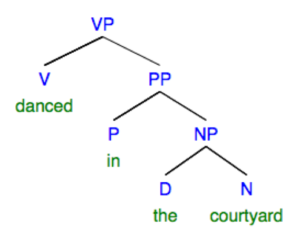
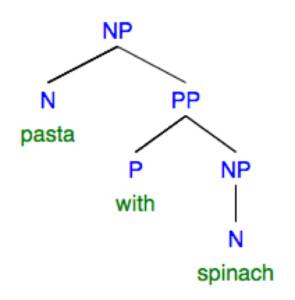
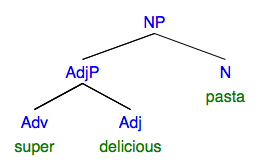
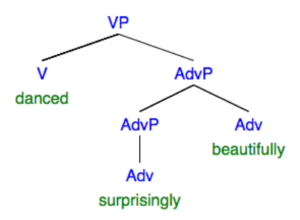
In this module we introduced some basic functions that phrases play in sentences: subject, verb phrase, and adjectival, adverbial. Subject is usually an NP. Adjectival function is often served by AdjP or PP. Adverbial function is often served by AdvP or PP.
I say “usually” and “often” because as we’ll see in future modules, things are slightly more complicated than this. But if you think in terms of these basic functions, it will be easier to extrapolate to different phrase types fulfilling them, later on.
2. Test Yourself: Quiz for Module 4, Advanced Unit
Complete before moving on to the next unit!